Scottish Social Attitudes Survey 2013: core module - attitudes to Government, the economy, health and social care services, and social capital in Scotland
This report presents findings from the Scottish Government core module in the 2013 Scottish Social Attitudes survey. It discusses changing attitudes to government, the economy and standards of living, the health service and social care, and social capital and life satisfaction.
This document is part of a collection
2 Scottish Attitudes Towards Government
Introduction
2.1 This chapter describes how the attitudes of people in Scotland towards both the Scottish and UK Governments have changed over time. The findings cover:
- Trust in government (to act in Scotland's interests, to make fair decisions, and to produce reliable official statistics)
- Public awareness of government activities
- Perceptions of the responsiveness of government
- Views of the relative influence of different institutions over how Scotland is and should be run
- The impact of having a Scottish Parliament on Scotland's voice within the UK.
2.2 The chapter also examines how attitudes, particularly those relating to trust and to influence, vary by socio-demographic subgroup, and whether any particular subgroups have changed their views disproportionately in recent years.
Trust in government
2.3 SSA 2013 included questions on three aspects of trust in government: i) trust in government (UK and Scottish) to work in Scotland's best long-term interests, ii) trust in government (UK and Scottish) to make fair decisions and iii) confidence in the accuracy of Scottish Government official statistics.
2.4 The proportion of people who trusted the Scottish Government 'just about always' or 'most of the time' to act in Scotland's best interests was 59%, and this has fallen from 71% in 2011 (Figure 2.1). Previous evidence from both the Scottish and British Social Attitudes surveys (Ormston & Reid, 2012, Ormston & Reid, 2011, Ormston, 2010, Curtice, 2012) has shown that public attitudes tend to be more positive in election years - a phenomenon sometimes called an 'election bounce'. The long running time series shows this phenomenon clearly, with local peaks in 2003, 2007, and 2011, the years in which an election was held in Scotland. However, it is also the case that levels of trust in non-election years have been consistently higher since 2007[12].
Figure 2.1 Trust in the UK and Scottish Government to act in Scotland's interests? (1999-2007, 2009-2013 % trust 'just about always'/'most of the time')
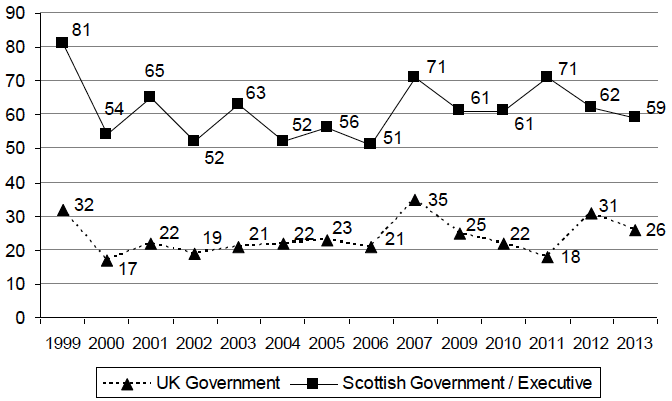
Base: All respondents
Sample size: see Annex A, Tables A.1 & A.2
2.5 By contrast, the proportion who said they trusted the UK Government 'just about always' or 'most of the time' to act in Scotland's interests was 26%. Ever since the SSA survey series began in 1999, levels of trust in the UK Government have been much lower than levels of trust in the Scottish Government. The figures for trust in the UK Government have been quite variable since 2007, with local peaks in 2007 (35%) and 2012 (31%), and a particularly low rating in 2011 (18%).
2.6 The level of public trust in the UK Government as measured in 2013 is similar to the levels of public trust in government within other jurisdictions both in Europe and the US. The Standard Eurobarometer measures the proportion who 'tend to trust' their national governments for each of the (28) EU countries individually, as well as reporting an average figure for all EU countries. According to this survey (Standard Eurobarometer, Autumn 2013), 24% of people in the UK reported that they 'tended to trust' the UK Government, a very similar result to the SSA measure of public trust in the UK Government (26%). The figure for public trust in the UK Government as reported in the Autumn 2013 Standard Eurobarometer 2013, was almost identical to the average figure for public trust in all EU-28 countries (23%). It is worth noting that the EU country with the highest rating in Autumn 2013 was Sweden (at 57%) whilst the lowest was Spain (at 9%). Levels of public trust in the US Government during the period of the Obama administration were also similar. Just over 1 in 5 (22%) of people said they trusted the US Government (Pew Research Centre, 2010).
2.7 SSA also asks a second pair of questions on trust in the UK and Scottish governments. These were first asked in 2006 and focus on trust in government 'to make fair decisions' which is defined as 'decisions that are fair to different groups of people in UK/Scotland'. The two sets of trust questions cannot be compared directly as they use different answer scales[13]. However, these questions show similar patterns to the previous pair in a number of ways. First, they show that the Scottish Government is more trusted than the UK Government (38% vs 20% in 2013). Second, they demonstrate the 'election bounce' effect for both UK and Scottish Governments, in that higher measures of trust are recorded in election years, with levels falling back in a consistent pattern in non-election years. And third, trust in the Scottish Government to make fair decisions has been higher since the first SNP government was elected in 2007. (Figure 2.2)
Figure 2.2 Trust in the UK and Scottish Government to make fair decisions? (2006-2007, 2009-2011, 2013 % trust 'a great deal'/ 'quite a lot')
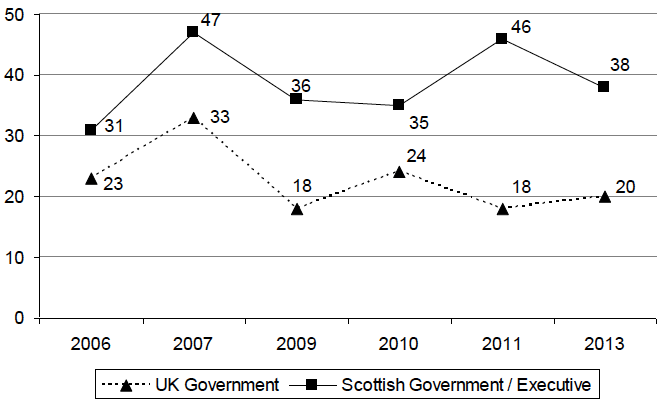
Base: All respondents
Sample size: see Annex A, Table A.3 & A.4
2.8 The third aspect of trust which was investigated relates to whether people have confidence that official statistics published by the Scottish Government are accurate[14]. Figure 2.3 below shows how confidence in official statistics has changed over time[15].
Figure 2.3 Confidence in accuracy of Scottish Government official statistics (2007, 2009, 2013, %)
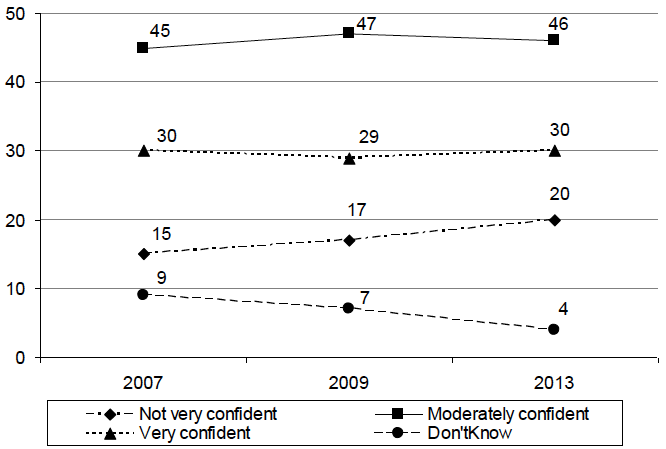
Base: All respondents
Sample sizes: see Annex A, Table A.13a
2.9 As can be seen in Figure 2.3, the proportions who were 'very confident' and 'moderately confident' in the accuracy of official statistics has been stable over time, and together these two groups represented three-quarters (75% -76%) of people in Scotland. However, the proportion who were 'not very confident' of the accuracy of official statistics increased from 15% in 2007 to 17% in 2009 and then again to 20% in 2013. This increase has been matched by a commensurate decrease in the percentage who said 'don't know'.
2.10 However, the levels of trust in the accuracy of Scottish Government official statistics in 2013 compared favourably with a recent study across Great Britain which found that 42% of those interviewed had 'just a little' or 'no trust at all' in information provided by statisticians (Ipsos Mori, 2013)[16]. Whilst these figures are not necessarily directly comparable (the question in the Ipsos Mori study asks about statisticians in general rather than about government statistics), the amount of distrust expressed in SSA is low in comparison.
2.11 The reasons people gave[17] for not being confident in the accuracy of official statistics were similar in 2013 to those given in 2007 and 2009 (see Annex A, Table A.13b). The reason given most often (chosen by around 1 in 5 on each occasion) was that 'official statistics are misrepresented or spun by politicians'. Other common answers included that 'statistics alone do not tell the whole story / there is more to it' (chosen by between 11% and 14%), and 'don't trust official statistics from personal experience' (chosen by around 1 in 10). Approximately equal numbers (around 1 in 10 on each occasion) offered the positive version of this last comment (i.e. 'trust official statistics from personal experience').
Public engagement and awareness of government
2.12 There is an ongoing emphasis within both Scotland and the UK to engage the public not simply at election time through their participation in voting, but with a broader spectrum of government decision making. The Christie Commission report (2011), referred to in Chapter 1 above has strongly recommended that the reshaping of public services in Scotland should be a collaborative venture, based on widespread and large scale participation of individuals and communities. A recent report by a UK Government committee (Commons Public Administration Select Committee, 2013) highlighted the importance of promoting and measuring public engagement at all stages of the policy cycle, and affirmed that citizens would be most likely to engage with Government if they believe they can make a real difference, or where the issue affects them. The study of civic participation in public policy to examine what governments and other agencies can do to encourage citizens to participate (in behaviours including for example recycling, volunteering, voting, petitioning, giving, donating) has incorporated insights drawn from the behavioural economics literature in the form of 'nudge theory' (Thaler and Sunstein, 2008; John, 2011).
2.13 A necessary - if not sufficient - precursor to public participation and engagement with the political process is awareness of government activities to which we now turn.
2.14 SSA asks people how much they have seen or heard about the activities of the Scottish and UK Governments in the last 12 months. Between 2004 (when the question was first asked) and 2009, the visibility of both the Scottish and UK Governments as measured by the percentage of people saying they had heard 'a great deal' or 'quite a lot' about their activities, increased. During this period the visibility of the UK Government was between 5% and 10% higher than that of the Scottish Government. By 2009 the levels reached 52% for the UK Government and 46% for the Scottish Government (Figure 2.4). However, the pattern has changed in more recent years. The visibility of the UK Government has fallen from its 2009 peak to the current level of 38%, which is close to the level of visibility in 2005. By contrast, the visibility of the Scottish Government reached a peak of 49% in the election year of 2011, and fell back to 41% in 2013. Although on the two most recent measurements (2011 and 2013), the visibility of the Scottish Government has been higher than that of the UK Government, these differences are not statistically significant.
Figure 2.4: How much have people seen or heard about the activities of the Scottish Government / Scottish Executive and the UK Government in the last 12 months? (2004-2006, 2009-2011, 2013, % heard 'a great deal' / 'quite a lot')
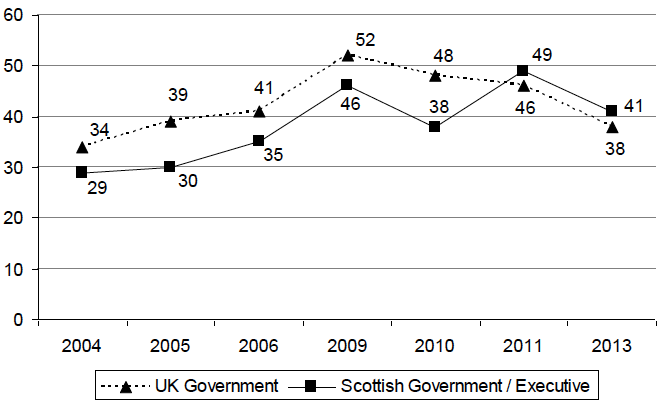
Base: All respondents
Sample size: see Annex A, Tables A.5 & A.6
Perceptions of government responsiveness
2.15 Another key element in supporting public participation is how responsive people feel the government is. People want to know that those in government are listening and that they will respond in a collaborative and consistent manner if at all possible (Binzer Hobolt and Klemmensen 2005, Farazmand 2004, Vigoda 2002, Bromley and Curtice 2002). If people believe that governments are unwilling to listen to their views or unable to act upon them they may feel there is little point in getting involved.
2.16 Since 2004, SSA has included questions on how good the Scottish Government and the UK Governments are at listening to people's views before taking decisions. In 2013, 46% thought the Scottish Government was 'very' or 'quite' good at listening to people's views before it takes decisions, compared with 21% who thought the UK Government was 'very' or 'quite' good. (Figure 2.5).
2.17 The figures for views of the responsiveness of both UK and Scottish governments increased slowly but steadily during the period 2004-2007, with the proportion believing the Scottish Government was 'very' or 'quite' good at listening being about twice as high (32%-43%) as the equivalent figures for the UK Government (15%-21%). However, from 2009 onwards the pattern has diverged somewhat.
2.18 Any expectation that the advent of a coalition government might increase government responsiveness through its potential ability to represent more people (Curtice and Seyd, 2011) has not been borne out. The figures for the UK Government since 2009 have remained fairly constant at around 1 in 5 (18%-22%). By contrast, the figures for the Scottish Government since 2009 have continued to increase. Notwithstanding the drop in 2013 from the election year high of 56% in 2011, there was a trend of increased perception of a more responsive Scottish government from 2007 onwards, when the first SNP led administration was elected.
Figure 2.5 How good are the Scottish Executive / Government and the UK Government at listening to people's views before taking decisions? (2004-2007, 2009-2011, 2013, % 'very good'/ 'quite good')
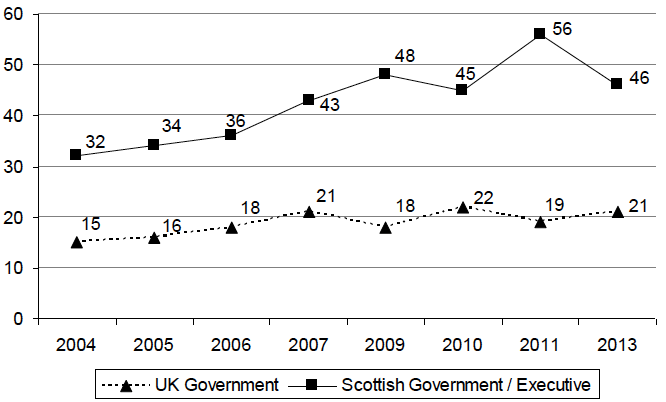
Base: All respondents
Sample size: see Annex A, Tables A.7 & A.8
2.19 Another way of measuring government responsiveness is to ask whether people think that having a Scottish Parliament gives ordinary people more say in how their country is run. Since 1999, SSA has asked people whether they think having a Scottish Parliament gives people in Scotland more say in how Scotland is governed, less say, or whether it makes no difference. These figures have displayed substantial variation over time.
2.20 From 1997 to 2002, the percentage who thought the Scottish Parliament would give / gave ordinary people more say dropped dramatically from 79% (when the question was phrased prospectively) when expectations were very high, to 31%. From 2002-2006 this figure increased a little, to 37%. A further change took place in 2007, when the proportion thinking the Scottish Parliament gave ordinary people more say (47%) was approximately equal to the proportion thinking it made no difference (45%).
2.21 This pattern, of fairly equal proportions offering each of these two responses, has been maintained during the period of 2007-2013, except in election years. In the UK election year (2010), the percentage who thought a Scottish Parliament gave ordinary people more say was lower (42%) whilst in the Scottish election year (2011) the percentage saying the Scottish Parliament gave ordinary people more say was much higher (60%). (Figure 2.6). This results in a heightened Scottish Government 'election bounce' effect of 2011, with subsequent measures (in 2012, 2013) returning to the levels recorded before the 2010 UK election. The longer time series now makes it clear just how pronounced the impact of the 2011 election in Scotland was.
Figure 2.6: Does having a Scottish parliament give ordinary people more say in how Scotland is governed, less say or is it making no difference? (1999-2007, 2009-2013, %)
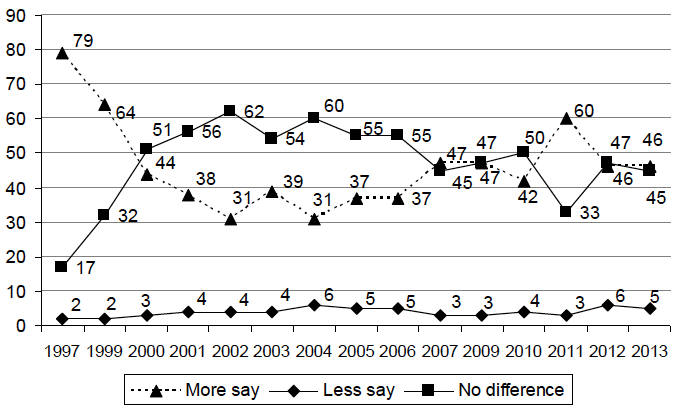
Base: All respondents
Sample size: see Annex A, Table A.9
Influence and Voice
2.22 Since 1999 SSA has asked people which institution - the Scottish government, the UK Government, local councils, or the European Union - has most influence over the way Scotland is run. The proportion that chooses the UK Government has been consistently higher than the proportion that chooses the Scottish Government with the exception of 2011, when the proportions were equal (Figure 2.7).
Figure 2.7: Who has the most influence over the way Scotland is run? (1999-2007, 2009-2013, %)
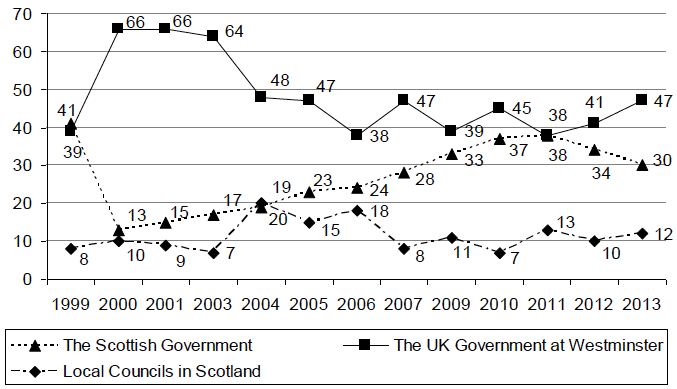
Note: The figures for European Union have not been included in Figure 2.7 for clarity of presentation. The percentage choosing the EU has ranged between 4% and 11%.
Full details are in Table A.10 in Annex A.
Base: All respondents
Sample size: see Annex A, Table A.10
2.23 There was a steady increase in the proportion who believed that the Scottish Government was the most influential institution from 2000 (13%) to 2011 (38%). However, this figure has fallen since the high point in 2011, and now stands at 30%, a level similar to that in 2007. By contrast, the proportion saying the UK Government is the most influential institution fell to its lowest level in 2011 (also 38%) but has risen substantially since then (to 47%).
2.24 While more people continue to believe that the UK Government has most influence over the way Scotland is run, a majority - 63% in 2013 - thought that the Scottish government ought to be the most influential (Figure 2.8). Over the period 1999-2013, the proportion who thought the Scottish government ought to be most influential has ranged between 63% and 74%. Within that timeframe, there have been two periods where the proportion has been consistently higher and two periods where it has been consistently lower. The periods where it was highest coincided with the early years (1999-2001) and the years following the 2007 election (2007-2011), whilst the times where it has been lower were the years following the 2003 election (2003-2006) and the most recent years (2012-2013) when the debate about Scottish independence has come into sharper focus.
Figure 2.8 Who ought to have most influence over the way Scotland is run? (1999-2007, 2009-2013, %)
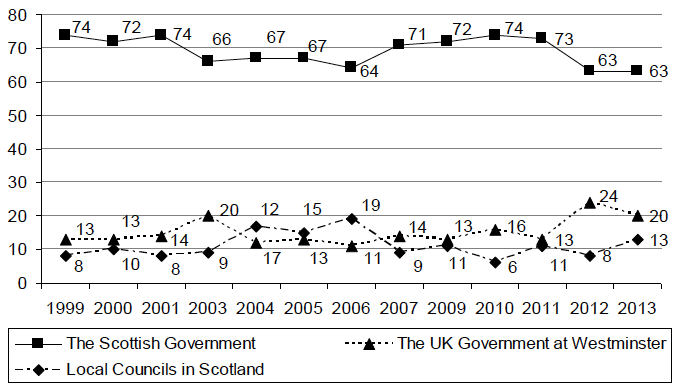
Note: The figures for European Union have not been included in Figure 2.8 for clarity of presentation. The percentage choosing the EU has been 1% or less over the period 1999-2013. Full details are in Table A.11 in Annex A.
Base: All respondents
Sample sizes: see Annex A, Table A.11
2.25 Finally, SSA also asks people whether they think that having a Scottish Parliament is giving Scotland a stronger voice in the UK, a weaker voice, or is making no difference. The proportions who believe that the Scottish Parliament is giving Scotland a stronger voice in the UK were at very high levels before the Parliament was established (70%), and then fell back in the first years of devolution, reaching a low point of 35% in 2004. Since then the trend has been upward, with particularly large increases in elections years followed by smaller falls in subsequent years. (Figure 2.9.)
Figure 2.9 Perceptions of the impact of having a Scottish parliament on Scotland's voice in the UK? (1999-2007, 2009-2013, %)
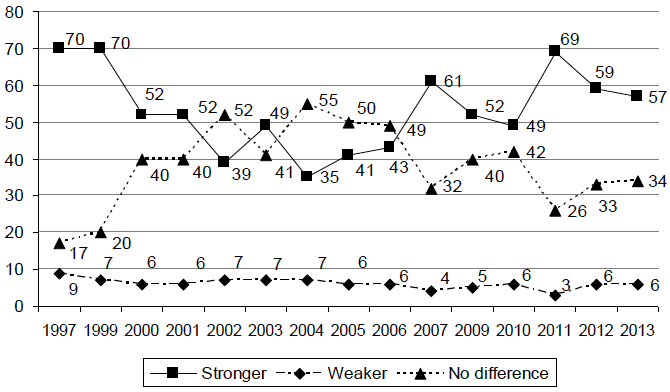
Base: All respondents
Sample size: see Annex A, Table A.12
How do attitudes to government vary?
2.26 The remainder of this chapter explores in more detail attitudes towards the Scottish Government and the Scottish Parliament in relation to public trust (both in the Scottish Government itself and in the official statistics it produces) and the perceptions of who does and who should have most influence over the way Scotland is run. This analysis complements and extends previous analysis on factors associated with differing attitudes to government as set out in earlier SSA reports.
2.27 Previous SSA reports (Ormston & Reid 2012, Ormston & Reid 2011, Ormston 2010, Ormston 2008, Ormston & Sharp 2007b, Curtice 2007, Given and Ormston 2007b, Bromley and Given 2005) have identified various factors associated with differing attitudes to government. Most recently, the analysis of SSA 2011 (Ormston & Reid 2012) confirmed that in terms of demographic characteristics, those most likely to express positive views about the Scottish Government and the Scottish Parliament included men, graduates, and those who read broadsheet newspapers. However, the analysis also highlighted that demographic differences were far less pronounced than differences by political attitudes. People who were interested in politics generally, SNP identifiers, and people who favoured more powers for the Scottish parliament, were groups who had particularly favourable attitudes to the Scottish Government and Parliament.
Trust in Scottish Government to work in Scotland's long term interests
2.28 As was noted in the earlier part of this chapter, despite the drop in levels of trust in the Scottish Government between the peak in 2011, and 2013, the overall levels of trust remain high in comparison both to trust in the UK Government, and in relation to other countries (see Para 2.6 above). A range of factors which might be expected to influence the extent to which people trust the Scottish Government to work in Scotland's long term interests, especially at a time of economic austerity, were examined. These covered economic and demographic factors (working status, employed in public or private sector, self-rated hardship, age), political factors (constitutional preference, awareness of Scottish government activities, and party identification) and other attitudinal factors (level of social trust, degree of trust in official statistics, beliefs about who should have the most influence over the way Scotland is run, and feelings of national identity.[18]
2.29 All of the factors examined, with the exception of sector of employment and self-rated hardship, showed variations in the patterning of trust in the Scottish Government to work in Scotland's best interests. The factors which differentiated between subgroups most strongly were: the constitutional preferences of respondents; their identification with a political party; their age; and their degree of confidence in the accuracy of official statistics published by the Scottish government. (See Table A.14 in Annex A.) For example:
- 77% of those who think 'the Scottish Parliament should make all the decisions for Scotland' trusted the Scottish Government 'just about always' or 'most of the time' compared with 26% of those who thought 'the UK Government should make all decisions for Scotland'
- 80% of those who identify as SNP supporters trusted the Scottish Government 'just about always' or 'most of the time' compared with 41% of those who identified with the Conservative Party
- 69% of those aged 18-29 trusted the Scottish Government 'just about always' or 'most of the time' compared with 50% of those aged 65 or over
- 88% of those who were very confident that the official statistics published by the Scottish government were accurate trusted the Scottish Government 'just about always' or 'most of the time' compared with 27% who were not very confident. This last finding shows how closely linked these different approaches to capturing underlying trust in government are.
2.30 As has been noted earlier, public trust in the Scottish Government decreased from 71% (in 2011) to 59% (in 2013). In general, the decrease in public trust was experienced by all subgroups, so that patterns across subgroups were similar in 2011 and 2013 (see Table A.14 in Annex A). The exceptions to this general trend were that:
- The youngest age group (18-29 year olds), whose levels of trust were similar to the overall population levels in 2011 did not experience any erosion of their trust (69% in 2013, compared with 72% in 2011)
- Levels of trust for those who have not seen or heard much about the Scottish Government in the last 12 months, has not fallen further from its low level in 2011 (47% in 2013, 50% in 2011)
- Those who support independence for Scotland, and SNP supporters, have retained their high trust ratings (77% in 2013 and 76% in 2011 for those who support independence; 80% in 2013 and 84% in 2011 for SNP supporters).
Confidence in the accuracy of Scottish Government official statistics
2.31 As far as confidence in the accuracy of Scottish Government official statistics is concerned, there is a clear trend with age, with those in the younger age groups having more confidence. As might be expected, the groups expressing a greater degree of confidence in the Scottish Government's official statistics include those who think the Scottish Government should have most influence over the way Scotland is run, those favouring independence or more powers for the Scottish Government, SNP supporters, those who describe their identity as 'Scottish not British' or 'More Scottish than British', and those who have seen and heard more about the Scottish Government in the last 12 months. (See Table A.15 in Annex A for further details.)
Influence on the way Scotland is and ought to be run
2.32 As has been highlighted earlier (Paragraphs 2.19-2.21 above), many more people think that the Scottish Government ought to have most influence over the way Scotland is run (63%) than think the Scottish Government does have the most influence on the way Scotland is run (30%). Indeed, more than one-third of people in Scotland (37%) believe that the Scottish Government ought to, but does not, have the most influence over the way Scotland is run. (Table 2.1).
Table 2.1 Who has, and who ought to have, the most influence on the way Scotland is run? (2013) (%)
| 2013 | |
|---|---|
| % | |
| Scottish Government has, and ought to have the most influence | 24 |
| Scottish Government has, and ought NOT to have the most influence | 6 |
| Scottish Government does NOT have, and ought to have the most influence | 37 |
| Scottish Government does NOT have, and ought NOT to have the most influence | 27 |
| (Don't know) | 6 |
| Sample size | 1497 |
2.33 This proportion varied markedly by political factors, but less so by attitudinal or demographic factors (see Table A.16 in Annex A). In particular, there were wide variations by constitutional preference, national identity, and party identification. For example:
- 52% of all those who said 'the Scottish Parliament should make all decisions for Scotland' thought that the Scottish Government ought to, but does not, have most influence over the way Scotland is run; this compared to just 12% of those who said 'the UK Government should make all decisions for Scotland'
- There is a steep gradient in relation to national identity (i.e. the degree to which someone feels Scottish, British or a mixture of the two). Just under half (46%) of those who said they think of themselves as 'Scottish, not British' believed that the Scottish Government ought to, but does not, have most influence; this compared to just 1 in 4 (24%) of those who think of themselves as 'British' or 'more British than Scottish'.
2.34 Almost half of SNP supporters (49%) thought that the Scottish Government ought to but does not have most influence; this compares to one quarter (25%) of Conservative supporters.
2.35 There was a small but significant trend in relation to who ought to and who does have the most influence over the way Scotland is run and self-rated hardship. One third (34%) of those who were 'comfortable' or 'very comfortable' on their present income thought that the Scottish Government ought to but does not have the most influence on the way Scotland is run. This compared to almost one half (45%) of those who were struggling on their present income.
2.36 The overall figure for the proportion who thought the Scottish Government ought to but does not have the most influence on the way Scotland is run has not changed since 2011 (it was 38% in 2011), and by and large the patterns across subgroups have not changed substantially. However, there was some suggestion that SNP supporters and those who were very interested in politics held this view more strongly in 2013 as compared with 2011. (See Table A.16 in Annex A.)
Contact
Email: Wendy van Rijswijk
There is a problem
Thanks for your feedback